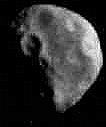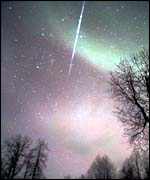The Solar System contains more than just nine planets and their moons. This page should fill a few gaps, and provide some surprises!
 In 1801, Italian Giuseppe Piazzi, discovered Ceres at a distance of 2·76 AU from the Sun. But with a diameter of only 1000 km, it was hardly a planet. It proved to be the largest of tens of thousands of rocks, asteroids, that lie in a circular orbit of ( 2·8 ± 0·5 ) AU around the Sun. Others are scattered throughout the system, many passing close to the Earth. More on Asteroids. In 1801, Italian Giuseppe Piazzi, discovered Ceres at a distance of 2·76 AU from the Sun. But with a diameter of only 1000 km, it was hardly a planet. It proved to be the largest of tens of thousands of rocks, asteroids, that lie in a circular orbit of ( 2·8 ± 0·5 ) AU around the Sun. Others are scattered throughout the system, many passing close to the Earth. More on Asteroids.
 When most people see a painting of a comet, they mistake it for a shooting star. In fact, comets are best described as muddy snowballs; just a few kilometres across. They can only be seen when their orbits bring them close enough to the Sun for frozen gases to evaporate from them, forming a reflecting halo, and streaming tail - always pointing away from the Sun. More on comets. When most people see a painting of a comet, they mistake it for a shooting star. In fact, comets are best described as muddy snowballs; just a few kilometres across. They can only be seen when their orbits bring them close enough to the Sun for frozen gases to evaporate from them, forming a reflecting halo, and streaming tail - always pointing away from the Sun. More on comets.
Top Right ^^
Navigate:
|
 This is the name given to small grains of dust to be found throughout the Solar System. It is material mainly left behind by disintegrating comets, and as such orbits the Sun in the same way. Much of the material is attracted by gravity towards the planets - and continuously hits them! The Earth, for example, receives tonnes of extra mass this way every day! During collision, the dust burns up, being seen as a shooting star: a meteor. More on meteor showers.
The Moon is the Earth’s sole companion; its only natural satellite. Neither of the inferior planets (Mercury and Venus) have moons, but all the superior planets have at least one. In this section, I intend highlighting the most interesting of recent discoveries. More on Moons.
This is the name given to the many small bodies found orbiting the Sun from beyond Neptune and Pluto. Many short-period comets are believed to come from here. More on KBOs.
The Oort cloud is a theoretical, spherical gathering of rocks at the outer edge of the Solar System. It is from here that the longer-period comets are believed to originate. More on the Oort Cloud. This is the name given to small grains of dust to be found throughout the Solar System. It is material mainly left behind by disintegrating comets, and as such orbits the Sun in the same way. Much of the material is attracted by gravity towards the planets - and continuously hits them! The Earth, for example, receives tonnes of extra mass this way every day! During collision, the dust burns up, being seen as a shooting star: a meteor. More on meteor showers.
The Moon is the Earth’s sole companion; its only natural satellite. Neither of the inferior planets (Mercury and Venus) have moons, but all the superior planets have at least one. In this section, I intend highlighting the most interesting of recent discoveries. More on Moons.
This is the name given to the many small bodies found orbiting the Sun from beyond Neptune and Pluto. Many short-period comets are believed to come from here. More on KBOs.
The Oort cloud is a theoretical, spherical gathering of rocks at the outer edge of the Solar System. It is from here that the longer-period comets are believed to originate. More on the Oort Cloud.
|


 In 1801, Italian Giuseppe Piazzi, discovered Ceres at a distance of 2·76 AU from the Sun. But with a diameter of only 1000 km, it was hardly a planet. It proved to be the largest of tens of thousands of rocks, asteroids, that lie in a circular orbit of ( 2·8 ± 0·5 ) AU around the Sun. Others are scattered throughout the system, many passing close to the Earth. More on Asteroids.
In 1801, Italian Giuseppe Piazzi, discovered Ceres at a distance of 2·76 AU from the Sun. But with a diameter of only 1000 km, it was hardly a planet. It proved to be the largest of tens of thousands of rocks, asteroids, that lie in a circular orbit of ( 2·8 ± 0·5 ) AU around the Sun. Others are scattered throughout the system, many passing close to the Earth. More on Asteroids.
 When most people see a painting of a comet, they mistake it for a shooting star. In fact, comets are best described as muddy snowballs; just a few kilometres across. They can only be seen when their orbits bring them close enough to the Sun for frozen gases to evaporate from them, forming a reflecting halo, and streaming tail - always pointing away from the Sun. More on comets.
When most people see a painting of a comet, they mistake it for a shooting star. In fact, comets are best described as muddy snowballs; just a few kilometres across. They can only be seen when their orbits bring them close enough to the Sun for frozen gases to evaporate from them, forming a reflecting halo, and streaming tail - always pointing away from the Sun. More on comets.
 This is the name given to small grains of dust to be found throughout the Solar System. It is material mainly left behind by disintegrating comets, and as such orbits the Sun in the same way. Much of the material is attracted by gravity towards the planets - and continuously hits them! The Earth, for example, receives tonnes of extra mass this way every day! During collision, the dust burns up, being seen as a shooting star: a meteor. More on meteor showers.
This is the name given to small grains of dust to be found throughout the Solar System. It is material mainly left behind by disintegrating comets, and as such orbits the Sun in the same way. Much of the material is attracted by gravity towards the planets - and continuously hits them! The Earth, for example, receives tonnes of extra mass this way every day! During collision, the dust burns up, being seen as a shooting star: a meteor. More on meteor showers.